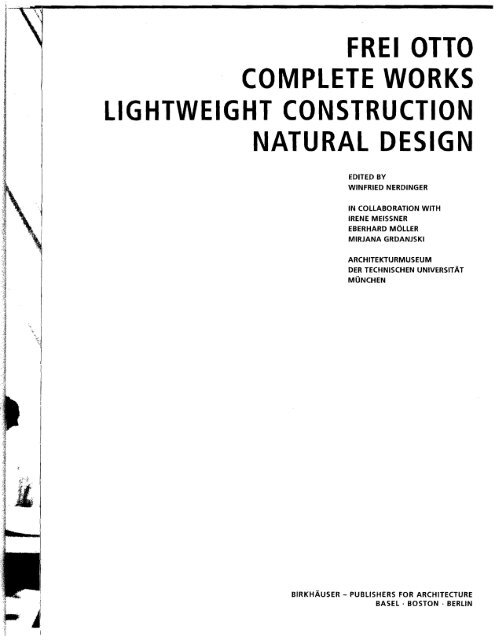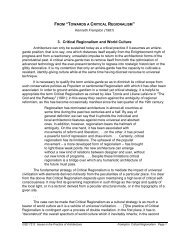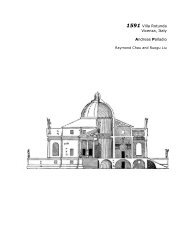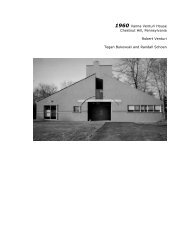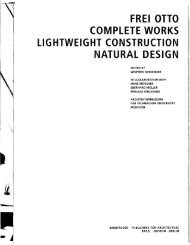Fret OTTO COMPLETE WORKS LIGHTWEIGHT CONSTRUCTION ...
Fret OTTO COMPLETE WORKS LIGHTWEIGHT CONSTRUCTION ...
Fret OTTO COMPLETE WORKS LIGHTWEIGHT CONSTRUCTION ...
Create successful ePaper yourself
Turn your PDF publications into a flip-book with our unique Google optimized e-Paper software.
CONTENT<br />
Foreword<br />
FreiOtto<br />
Working for a Better "Earth for Mankind"<br />
Winfried Nerdinger<br />
Natural Forms - Architectural Forms<br />
Rainer Barthel<br />
The Lightweight Principle<br />
Eberhard Moller<br />
Frel Otto and Biology<br />
Ulrich Kull<br />
In Harmony with Nature and Technology<br />
On Frei Otto's Architecture and Work Method<br />
Irene Meissner<br />
MODELS AND EXPERIMENTS<br />
Where Architecture<br />
and Civil Engineering Meet<br />
Rainer Graefe<br />
Institute for Development of Lightweight<br />
Construction and Atelier Warmbronn<br />
Ewald Bubner<br />
The Institute for Lightweight Structures<br />
University Institute and Spinners' Centre<br />
Berthold Burkhardt<br />
Frel Otto and Ove Arup<br />
A Case of Mutual Inspiration<br />
Christian Brensing<br />
Frel Otto and Ted Happold<br />
1967-1996 and Beyond<br />
Michael Dickson<br />
Ethics, Aesthetics and Innovation<br />
A Speech by Frei Otto<br />
6<br />
8<br />
16<br />
32<br />
44<br />
56<br />
64<br />
70<br />
80<br />
90<br />
102<br />
110<br />
124<br />
<strong>WORKS</strong>HOP OF IDEAS<br />
DRAWINGS AND SKETCHES<br />
CATALOGUE OF <strong>WORKS</strong><br />
Buildings and Projects 1951-2004<br />
Irene Meissner, Eberhard Moller<br />
Appendix<br />
Frei Otto and Projects in the Orient<br />
A Personal Account<br />
Bodo Rasch<br />
Homage to Frel Otto<br />
Biography<br />
Bibliography<br />
Contributors<br />
Glossary<br />
Index of Names<br />
Index of Locations<br />
Thanks<br />
Illustration Credits<br />
130<br />
168<br />
360<br />
362<br />
368<br />
370<br />
383<br />
384<br />
386<br />
388<br />
389<br />
390
G<br />
1<br />
B<br />
u<br />
1<br />
V<br />
9
Oval exhibition hall, Nijni Novgorod, Russia, 1896<br />
Arena in Raleigh, North Carolina, 1950-1953<br />
22 Cf. R. Buckminster Fuller. Utopia or Oblivion:<br />
The Prospects of Humanity. london 1970; Idem.<br />
Operating Manual for Spaceship Earth. New York<br />
1963; Idem. Konkrete Utople. Duesseldorf 1974,<br />
"the general principle finding ways of doing more<br />
with less".<br />
23 Wilhelm. 1985 (note 6), p. 80<br />
24 Frei Otto. "Stuttgarter Architektur gestern,<br />
heute und morgen". 1979, quoted from Burkhardt<br />
(note 2), p. 166; Frei Otto. "Die neue Pluralitat und<br />
das Verhaltnis zur Natur" . Systeme als Programm,<br />
arcus, Architektur und Naturwissenschaft, B.<br />
Cologne 1989, pp. 30--33<br />
25 Frei Otto, "Das Zeltdach, 5ubjektive Anmerkungen<br />
zum Olympiadach", Allgemeine 8auzeitung,<br />
1972, quoted from Burkhardt. 1984 (note 2), p. 98<br />
26 "Ein Zeit-Gesprlch" (note 1)<br />
27 "Die Kongrellhallen-Debatte" , Bauwelt, 1958,<br />
pp. 13-16, quoted from Burkhardt. 1984 (note 2),<br />
p,45<br />
28 Frei Otto. Oas h.fingende Dach. Berlin 1954,<br />
pp.88-93<br />
29 Wilhelm. 1985 (note 6), p. 71; Frei Otto.<br />
"Moderne Architektur", Burkhardt. 1984 (note 2).<br />
pp.62-63<br />
12<br />
Lightweight building and "liberation" are linked for Frei Otto as well. But unlike<br />
many other advocates of programmatic Modernism he did not believe that trans<br />
parent material or lightweight constructions alone can improve the world we live in,<br />
as "constructions are not bound to scale. They can be enlarged and reduced several<br />
times by the power of ten, they still work, (and so) we should be aware that con<br />
structions do not actually have anything to do with people. "23 So the crucial feature<br />
for him is the link with people and the quality of the structures for people. He does<br />
however strictly reject the woolly term "humane building", which is mostly applied<br />
to use, as he is not concerned with the well-being of individuals: "Buildings are<br />
'humane' only when they promote peaceful human co-existence. "24 This ambitious<br />
claim is one of the reasons why Frei Otto is never content with a solution that has<br />
been found once, and why a certain form of lightweight construction never became<br />
a universal architectural solution for him: '" have never been satisfied with a piece<br />
of work I have been actively involved in, and would never want to be."25<br />
Do not build prestigiously. but ephemerally<br />
For Frei Otto, lightweight construction does not just mean minimising mass, mate<br />
rials and energy, but always building adaptably, changeably and thus "ephemerally".<br />
This attitude is also based on experiences with the "Nazis' whispers of eternity" .2'<br />
Official National Socialist architecture was intended to give an impression of eternity<br />
and permanence through its monumentality and mass, and to represent the state as<br />
a symbol of power. So throughout his life Frei Otto has rejected not just heavy archi<br />
tecture, but also any form of symbolic or prestigious architecture. The "thousand<br />
year Reich's" claim to eternity, intended to be made visible and manifest in marble or<br />
granite buildings, has always been profoundly repugnant to him. lightweight build<br />
ings, deliberately conceived to be changeable and removed, and that convey no claim<br />
to being prestigious or imposing, are his response to the leaden NS architecture,<br />
expressing contempt for people. He therefore reacted correspondingly violently to<br />
the return of the monumental after the Second World War.<br />
The Berlin Kongresshalle was allegedly an architectural sign of "free discussion",<br />
financed by the USA and built by Hugh Stubbins in 1956. Frei Otto was the only<br />
person to turn against the new form of symbolic, prestigious architecture when he<br />
declared: '''Free discussion' cannot be built, but it can be made possible through<br />
building. "27 In a discussion with the architect and the engineer Fred N. Severud<br />
he criticised the luxurious materials, the pompous platform, the theatrical monumen<br />
tality and the heavy pressure beam in the roof. As a counter-model, Frei Otto<br />
sketched Matthew Nowicki's suspended cable net construction between two parabo<br />
loid reinforced concrete arches for the Arena in Raleigh, whose light, unpretentious<br />
structure with its bright, completely column-free space had profoundly impressed<br />
him even at the design stage on the visit to the USA in 1950, and given important<br />
impetus to his own experiments with tents and cable nets.'" Frei Otto's view was<br />
confirmed, late but sadly, when the peripheral beams of the Kongresshalle, exces<br />
sively large for reasons of prestige, and which he had particularly criticised, collapsed<br />
in 1980.<br />
Frei Otto subsequently always criticised buildings with a claim to being imposing<br />
or symbolic, even if they had been designed by the most famous architects, like<br />
Le Corbusier's concrete tent and the Atomium, which for him symbolised only the<br />
nuclear threat, at the 1958 Brussels World Fair, Eero Saarinen's bird-shaped TWA<br />
terminal in New York or the sails on Jorn Utzon's Sydney Opera House,'" But he was<br />
particularly outraged when James Stirling's design for the Neue Staatsgalerie was<br />
chosen for realisation in "his" city of Stuttgart. He did note positively the fact that<br />
Stirling had outdone the Stuttgart architecture cliques, who he felt "shaped the face<br />
of the city in a petit-bourgeois fashion with the device of competitions, which look<br />
so democratic," as is the practice everywhere, but he saw the new building as<br />
nothing but "stone stage-set walls with gigantic cornices that do not support a roof.<br />
Fortress architecture with claims to eternity. A demonstration of power as a back
40 Frei Otto. Bodo Rasch. Gestalt finden. Auf dem<br />
Weg zu einer Baukunst des Minima/en. Munich<br />
1995<br />
41 Frei Otto. "Die Zeit der vielen Architekturen".<br />
Allgemeine Bauzeitung, 1972, quoted from<br />
Burkhardt. 1984 (note 2), p. 122<br />
42 Frei Otto. "Subjektives und Kritisches zu dem,<br />
was andere als mein Werk bezeichnen". Wilhelm.<br />
1985 (note 6), pp. 162-163<br />
43 Frei Otto. "Hert endlich auf". Burkhardt. 1984<br />
(note 2), p.147<br />
simulate form-finding and optimisation processes. 40 And understanding the processual<br />
character of natural constructions in its turn almost inevitably produces a position<br />
that runs completely counter to the individually fixed formal expression of the" artist<br />
architect", whose products Frei Otto feels are simply "show-off architecture"", even<br />
though it dominates the architectural magazines. And so at best, he played the role<br />
of an outsider to the architecture scene, was rarely invited to take part in competi<br />
tions, and never appointed to serve on judging panels.<br />
Frei Otto's visions are aimed at tents with minimal surface areas, at grid shells stabilised<br />
by inverting traction lines, at pneumatic envelopes whose form is determined by<br />
pressure ratios and that sit on the landscape like a second skin, or at buildings<br />
that can be adapted to their particular needs by changing owners and can always be<br />
altered. For him, this work on natural constructions is part of a rational form-finding<br />
process following natural laws, but it is also part of a larger vision directed at a<br />
peaceful and free society in harmony with itself and nature. The ascetic architect falls<br />
into astonishing dreams of "sensual architecture"" as part of these visions, of a<br />
"delicate, heavenly collage ( ... ) on the theme of peace and love", or of building a<br />
kind of "love pavilion", as ultimately for Frei Otto work on mankind's earth leads<br />
to "peaceful love-architecture "43 in a "happy cultural landscape" . A dream that he<br />
does at least dream, unlike most architects, as for him "visionary imagination is<br />
never utopian" .<br />
15


